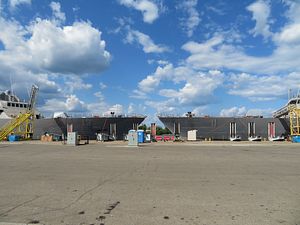The U.S. Navy accepted delivery of two Freedom-class Littoral Combat Ships (LCS)—the future USS Sioux City and USS Wichita—at the Fincantieri Marinette Marine shipyard in Wisconsin on August 23, the service said in a statement. The two vessels are the 14th and 15th LCSs to be delivered to the U.S. Navy and the sixth and seventh of the Freedom-class to join the service.
Both LCSs completed their last round of acceptance trials over the summer, which included a series of graded in-port and underway demonstrations, among other things. The acceptance trials were conducted by the U.S. Navy’s Board of Inspection and Survey, the U.S. Navy’s principal body inspecting and reporting on a warship’s readiness for active duty operations.
“The future USS Sioux City is a welcome addition to the East Coast Surface Warfare Division, the commander of LCS Squadron 2, Captain Shawn Johnston, said. “Both her Blue and Gold crews are ready to put this ship though her paces and prepare the ship to deploy. The future USS Wichita is the first East Coast Mine Warfare Division ship,” he added. “She will have a chance to test some of the latest and greatest mine warfare systems after she completes her remaining combat systems trials.”
As I explained previously:
Using an open architecture design, both LCS classes — the mono-hull Freedom and trimaran-hull Independence variants — are modular, reconfigurable warships that can be fitted with interchangeable mission packages providing specific capabilities for surface warfare (SUW), anti-submarine warfare (ASW), and mine countermeasures (MCM) missions in the littoral region.
The standard armament of a Freedom-class LCS consists of a 11-cell Raytheon RIM-116B SeaRAM missile-defense system, a 57-millimeter naval gun, and Mark 5o light-weight torpedoes launched from torpedo tubes.
In the near future, LCSs will also be armed with the so-called Surface-to-Surface Missile Module, a 24-shot vertical launch system designed to engage smaller surface targets in close proximity to the LCS with AGM-114L Longbow Hellfire missiles. (Initial operational capability is expected by the end of 2019.)
Furthermore, the ASW warfare package is slated to become available next year, the MCM package by 2020. Nonetheless, don’t expect the LCS to be deployed in battle, as a January 2018 report by the Pentagon’s office of Operational Test and Evaluation notes:
Survivability testing and preliminary analyses on both LCS variants continue to demonstrate that neither LCS variant is survivable in high intensity combat. Although the ships incorporate capabilities to reduce their susceptibility to attack, testing of analogous capabilities in other ship classes demonstrated that such capabilities have limited effectiveness in high intensity combat.
The U.S. Navy’s fleet of LCSs is divided into two separate classes, the Independence and Freedom variants. Construction of the Freedom-class is spearheaded by Lockheed Martin at Fincantieri Marinette Marine shipyard in Wisconsin, while the building of Independence-class ships is led by Austal USA in Alabama.
Notably, while 11 LCSs have been commissioned to date, not a single ship of the class has been deployed in 2018. According to Defense News, four LCSs may be ready for operational deployment next year.

































